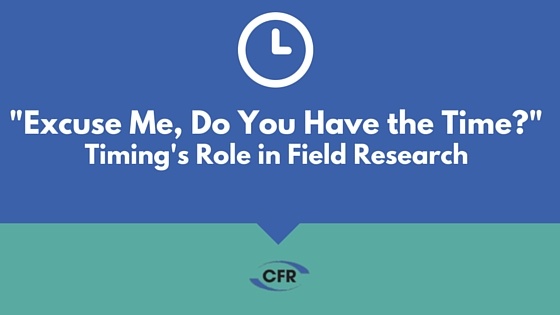
“Excuse Me, Do You Have the Time?”: Timing's Role in Field Research

While many field research teams take care to consider various market demographic variables, they often leave out another critical variable: time. By itself, time can be a major factor that influences study data like survey responses. For instance, surveying a cohort about their utilities experiences right after a natural disaster could yield different responses than surveying during any other typical day.
In the long run, however, time can become a dependent variable that allows unexpected independent variables to manifest themselves. Measuring brand preference over time could be one example, particularly over periods stretching both before and after holiday shopping seasons.
Help your team think more about how time affects results during field research design with these important time-based concepts.
Cross-Sectional vs. Longitudinal
One of the more basic concepts in research is the contrast between a cross-sectional and a longitudinal study. Just as a brief recap: cross-sectional studies gather data samples at one time, showing a cross-section of how the population or subject was represented at the time, while longitudinal studies follow a study group over time, observing how behaviors, preferences and any trends manifest themselves within the period.
The problem with many field research study designs is that they fail to recognize that cross-sectional observations are not the automatic default. Since these cross-sectional studies often require less resources than long-term longitudinal ones and have less factors like subject dropout to be concerned with, research design still defaults to them.
Cross-sectional studies are not objectively “bad” in any way, but research designers simply must account for the specific limitations and unique considerations of the structure. If they acknowledge these factors and can still justify that a cross-sectional approach is appropriate, then they are one step closer towards having a clearer interpretation of the data.
Field Research Timing
Aside from considering how to structure a study, deciding when to conduct a study could have a large impact on its findings. An excellent example is polling during a presidential election year. Early polls often see a more evenly-spaced candidate field within political primaries. But, as the media publishes primary results from states that vote early on, public opinion can often be swayed in favor of the candidates with the strongest performance so far. Therefore, running a study on such a time-sensitive subject matter can often reveal much more about how timing affects opinions, behaviors and decisions more so than how a subject genuinely feels about the polled topic as a whole.
Moving from the realm of politics, industry market researchers conducting field studies must be aware of how circumstantial changes can affect data results. Notable events, such as the recent decrease in gas prices, could have a relevant impact on conclusions and strategies deduced from the data.
To summarize: field research study design must take time into consideration in order to strengthen the gathering of data, and the interpretation of that data, as it relates to more complex conceptual frameworks.
Another critical decision for research teams lies in how they choose whether or not to engage with a field data collection partner. You can read our free guide to accelerating growth with the right field data collection partner to get started.


